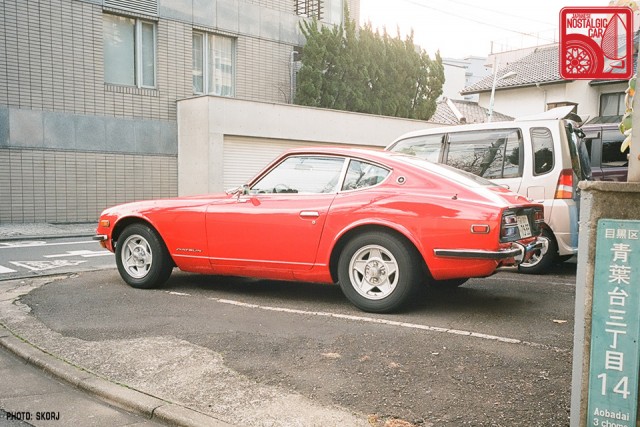
Welcome to the final installment in our multi-part treatise on short-term automobile storage in Japanese society. In Part 01 of the investigation we studied what was within and without the bounds of the law, as well as the ubiquitous steel-bar-rising-up-out-of-the-ground parking lots. In Part 02 of the dissertation we considered the boom-gate lot and the car elevator building. Here are the final three practices by which you can leave your vehicle unattended.
4. Parking Meters
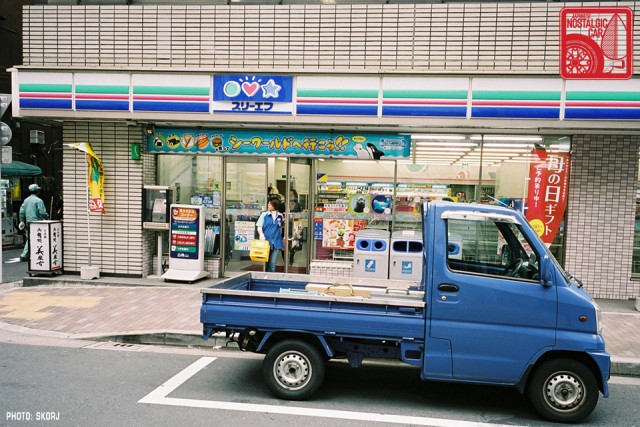
The “Pay As You Go” parking meter option is pretty boring, easy, and does not lend itself to humorous writing. Essentially, just a series of smart parking meters and printed ticket dispensers. With nice convenient rectangles marked on the pavement — like occupied by this blue kei truck — there’s no need to even guess where you can and cannot park.
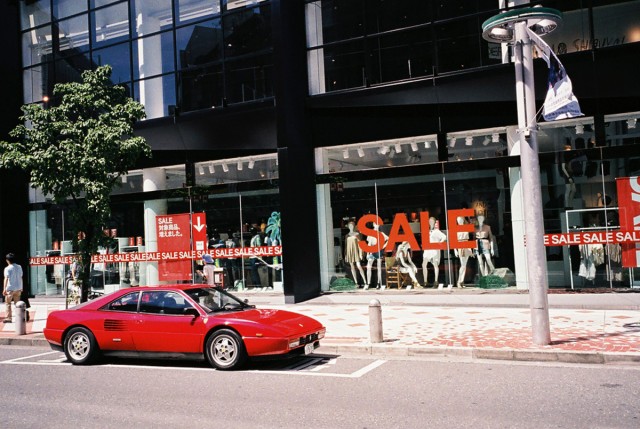
While the police sometimes use the marking the tires with chalk technique to check if someone has continually parked in the one space, rolling forward a few centimeters won’t help. The standalone smart-meters’ position sensors reset only when the car has completely moved from the space.
If you are really lucky, some of the Pay As You Go locations are free on weekends and public holidays. Some though, become No Parking zones after hours, and you can be fined regardless of having a receipt or not.




Pay As You Go meters even apply to bicycles. Here, the green Pay and Display ticket in a Chiyoda-ku location sits next to an equally complicated bicycle parking system. The blue payment machine is making a valiant effort to explain how simple the process really is, and with the buildup to Tokyo’s 2020 Olympics everyone is making a huge effort to provide English and support for foreigners. Based on Chiyoda-ku’s “Description for Foreigners” QR coding work here, everything is obviously going to go smoothly for all the athletes that decide to bring their bicycles with them.
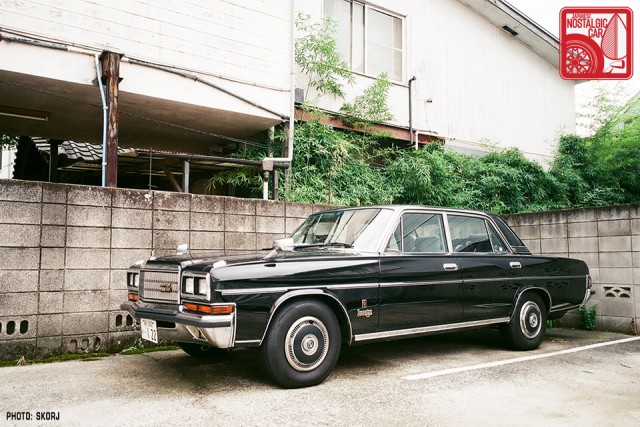
5. Private Monthly Parking
If you’re lucky, someone might have an un-used car park or a block of land near where you live — remember, to register a car you need to prove you have parking within a 2 kilometer radius of your home, unless it is a kei — and is willing to rent spaces on a per-month basis. Typically in and around Tokyo, they are 20,000 to 40,000円 ($165-300) a month. Some Tokyoites have private monthly parking near their home (for an extra car, as most homes only include one spot), at their work (as I do), or near their mother (because she’s paying for it so you can visit when she needs a lightbulb changed).
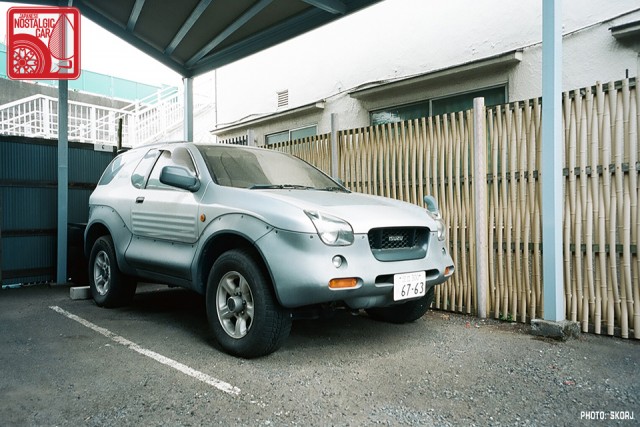
Unlike similar situations outside of Japan, the license plate number or perhaps car park number are not generally displayed. So, private car parks are generally not numbered. Therefore, if you are circling a residential area and see a lot with parking lines but no numbers, that’s not an invitation to drive on in.

Note, too, please, that parking in someone else’s private monthly car park is considered the ultimate height of rudeness. In doing so, you might even come back to your car and find a note on your windscreen saying something like, “We are very sorry, please forgive us contacting you in such a rude manner, but this car park is reserved. If it is not too much trouble, could you please try and park somewhere else next time? Sorry to be so impertinent, and please drive safely.” This is only conjecture of course, because in all the history of all of Japan no one has ever parked in someone else’s private monthly car park.

6. Park Like a Yak
This is my all-time favorite. Like these Toyota Century, there is one method that has no concerns about cost, inconvenience, congestion, manners, or ease of access: You just park anywhere you choose, anytime. On the surface this comes close to being free, but like everything in the yazuka world these days, it comes with a number of requirements before you can attempt this common method of parking in Japan.
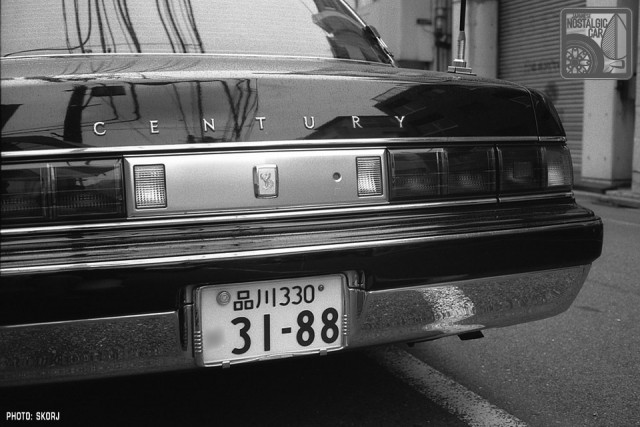
The first clear requirement is that only certain types of car are allowed to park yakuza or even just yakuza-like. Your car has to be big, black (or perhaps gray or dark blue), and it needs fender mirrors (or at least must have the catalog option for ordering fender mirrors). 88-88, a lucky number for much of Asia, on the license plate helps, as does an arrogance to not even look vaguely concerned about inconveniencing others.
I’ve seen a black Century park in a one-way street, the wrong way, holding up a siren-wielding ambulance, and the ambulance reversed back to avoid inconveniencing the Toyota V12’s magnificence.

In some jurisdictions too, continued and regular payment of multiple 10,000円 notes — in a standard Japanese manila envelope — to the local police is also required to secure the continued ability to continue to park like a yak.
Taxi companies, some of which are either yakuza-operated or yakuza-affiliated, function on similar principles. Notably, in very high traffic areas whole lines of just one brand of taxi can and will block off entire intersections as they wait for lucrative business from passengers coming off of the last train of the night.
Normal humans with a full five digits on both hands, however, like the occasional housewife in her Cube, a salesman in his Prius, or a tradesman in his Probox are not allowed to try and park like a yak.
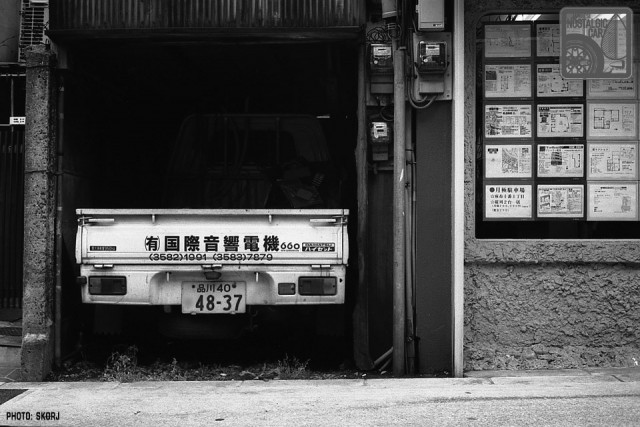
With space at a premium in Tokyo, there are still ways of storing your car when you aren’t driving it. They just tend to cost something, whether it’s money, the risk of a fine, or the gradual erosion of society. Regardless of which option you choose, though, they are all better than taking the easy way out and just leaving your car in a remote barn, never to be driven.
Skorj is a photographer living in Japan, co-founder of Filmwasters, and shoots in actual film.






Great article. Just one question: there are public free parkings like the famous Daikoku, right? If so, could you park your car in a such place, and then just leave it there ’til the next day or so?
Thanks.
They are essentially expressway rest stops, either remote house-wise, or inaccessible to foot traffic. Just ask someone here! You can taxi there, but the fares would far exceed the cost of closer. Plus! In order to buy a car, you have to demonstrate you have a registered car-park AND it needs to be within 2km or so of your house. Double-plus, Nexco tow abandoned cars from PA, so it would lucky to stay there for more than few days…
So it is the same as here. Pay now (legal) or pay later (parking violation).
Parking like a yak gets your car towed.
I was really hoping to see a Yak parked somewhere. Or at least a water buffalo, since Yak are hard to find in Japan.
Love your reports Skorj. Keep ’em coming.
They are also extremely difficult to parallel park. Always makes for a good YouTube video.
Parking series, I’m going to miss you (no lie). I know that you must be kidding about all of the folks in Japan (at least, those of Japanese descent) being so polite, (leaving the world’s most polite note on the parking offender’s windshield) but, I believe it! And, it makes me love the country and its people even more than I did before. Thanks for a great glimpse into real life in the Motherland.
And, I want that Honda City Cabriolet!
Hai! Those wheels!
Where are you located, Scotty? I know of one that might be for sale in Canada.
You are very brave to photograph the Century if it belongs to a real Yak. Kudos.
Great series, enjoyable as always. Thanks.
The black and white photograph was indeed a yak-mobile. The suited driver / minder also missing a digit. It was Dogenzaka or perhaps Maruyamacho, and they were unloading their boss for what I am sure a fun time for all…
You saved the best for last. Awesome.
The car says century, but the plate says bicentennial? Enjoyed the series and great mix of cars that got slipped in, especially that debonair herd of yaks.
Of course I have; there’s a bunch of them over there…
You mean that’s not a 1976 Gran Torino?
Loved this series, Skorj. Chuckled several times and enjoyed the great shots and mix of cars peppered throughout. Thanks for writing and sharing your experiences!
Thanks… When I started, I thought a half page with some nice pics, but after starting it just piled up.
Great series, I am so glad my boss always drove in Tokyo. I want to share this with everyone who complains about parking here in Tacoma.
I would add the heavy use of hazard lights when legitimate parking is not available. It took a while for me to get used to all of the cars with flashes on outside Family Mart, book stores, ramen shops, really any place that you can visit in less than 15 minutes.
Hey Skorj
So to have indoor parking for your classic car would be kinda rare, right?
Hi Kev. For the regular Tanaka-san with his house in Tokyo, that depends on how many cars he has. If just one gorgeous Hako, then likely you can get a place that has undercover, or semi-cover for one car easy. Getting two (one for a Hako, and one for a Toyota 2000GT perhaps) in Tokyo is where it starts to get tricky. Some large apato though you can rent two places if you are lucky.
But after ten years in one house in Shibuya-ku with two places, we just moved and out of the 100 or so places we looked at only one had indoor for 1.5 cars (1 for CR-V plus 0.5 for S800), and perhaps just five had two both outside.
In some of the outer -ku you would likely have a better chance too. One of the places we looked at was in Denenchofu and it had one long driveway, with one place near the house under cover, then four places all in a line to the street. Usable, but a shuffle-game nightmare.
Some classic car fiends rent garage, warehouse, or spare places remote to allow multiple (tens, hundreds sometimes) classic cars to be stored. I’ve seen one private garage that would rival the Lane Motor Museum. But that’s a different story that goes with my neighbor having had four places specially built for him, and his pre-war Alfa and Maserati (viewable behind air-conditioned glass from his living room), and there’s a whole magazine called Garage Life dedicated to those…
There’s your next story!
Classic/Collector/Nostalgic vehicles, and where to put them!
That actually seems to be an issue everywhere, so would be interesting to see how it’s handled there.
Oh yeah – any special design to protect the classics from earthquakes, in addition to the elements? Legitimate question out there…
Great series! It amazes me how, those lucky enough to have a TINY private stall attached to their house (like the little Kei truck above), can get out of their car without a sunroof. Maybe they push it in or winch it… I think some of the Carports they sell in the big box hardware stores are kind of stylish. Wish they would sell them in the US. “Garage Life” crax me ups.
Skorj; When you purchase a car, you have to show proof of parking. What does that look like?
Again, thanks for the great series.
Proof of Parking is a whole process in itself. Forms, forms, and more forms. Maps, photographs, proof of residence, inkan and hanko, proof of car ownership, latest shaken, proof of residence, on-site inspection, then the process can start. At the conclusion, you get one of these:
https://farm6.staticflickr.com/5771/22596285484_b62be30a08_b.jpg
Which shows the car chassis type, dimensions (to the mm), where I park the car and where I park me. Lucky in my case they are the same. The car has to be 2km from the me, hence the map bit. The policeman who measured my site ten years ago must have been 80 years old, drove a neat little lights and radio equipped kei truck, and spent nearly an hour measuring the spot. Averaging the dimensions as mine is not symmetrical. Ooohhh, the pain that was.
With the above, you get one of these:
https://farm1.staticflickr.com/623/22830574647_5009b5f6c8_o.jpg
A sticker for your car, which of course corresponds to the number on the certificate…
I attended school on base; a displaced microcosm of a Midwest town. The first thing they remind you is that we are visitors in Japan. I could see how some serviceman from NYC could run afoul of the law in a second.
As we say at work when in Japan…It’s all about the process!
Great series and was good to read.
“Note, too, please, that parking in someone else’s private monthly car park is considered the ultimate height of rudeness. In doing so, you might even come back to your car and find a note on your windscreen saying something like, “We are very sorry, please forgive us contacting you in such a rude manner, but this car park is reserved. If it is not too much trouble, could you please try and park somewhere else next time? Sorry to be so impertinent, and please drive safely.” This is only conjecture of course, because in all the history of all of Japan no one has ever parked in someone else’s private monthly car park.”
This happens here on a daily, if not hourly basis(It’s happening right now outside my business with one of our private spots). And if you dare say something or leave a note(politely of course), you are made out to be the A-hole. The world could learn A LOT from Japan.
Now THAT part’s a shame – that YOU’RE the jerk for bringing to someone’s attention that THEY’RE a jerk… Meanwhile, a fellow employee is stuck, or, worse in the business world, a customer has a harder time giving your company money…
What happens if you have the offender towed?
I’m guessing torching it is out of the question. 🙂
Who will be the first with a “Park Like A Yak” plate frame?
Nice rare set of ATS’s, you do not see those wheels every day.
On the Fairlady? I checked, and they were Campagnolo, which here at least was possibly rarer?
Just started reading these and I am really enjoying the inside look at the oddities of life in Japan. Mostly, I had to comment on the picture of the Vehicross. Very cool seeing a picture of one in the wild in Japan! How often do you see one there?
I own one here in the states and am lucky enough to see a few regularly as well.
They are rare in Japan. I think I see maybe one per year. Most in silver, one in burnt orange, and one in yellow to date. The bright colors look pretty neat!
Very informative articles, thanks.
I can’t get any answers though about the WHY – is there any reason why they have the 2km law? Why don’t they permit you to have parking spaces further away? For example I have a friend with space for 3 cars who is happy for me to park there (and it’s really close to where I need to drive it), yet as its over 2km from my house I can’t do that. Ridiculous.
On one hand they say a parking space is compulsory to reduce congestion, yet at the same time force me to drive a car into and out of an area, and create more congestion, simply to park it!
What (in their view) is wrong with parking somewhere else?
You also mention hobbyists with many cars kept remotely. Do these collectors also have to pay for a parking place for each of their cars within 2km of their home, even if the cars are never there?
> What (in their view) is wrong with parking somewhere else?
Easy! Just as you have found, if you go far enough from where you `have` to have your car park, you can park for free! I can of course do the same, and so can countless others. This is Japan, and that just would not satisfy the lobbyists from the car park companies that `donate` to politicians. So, make a law to stop people doing that. The same answer that is used for countless other `why…` questions; to secure revenue streams for those that control it.
> Do these collectors also have to pay for a parking place for each of their cars within 2km of their home, even if the cars are never there?
Yes, but they only need one. The same one. All the cars can be registered to the one place – I think anyway. Unless there`s a money angle there too somewhere…